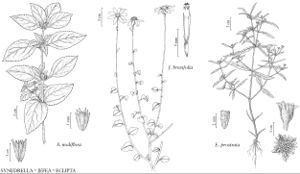Eclipta
Mant. Pl., 157, 286. 1771.
| Taxon | Illustrator ⠉ | |
|---|---|---|
 | Synedrella nodiflora Jefea brevifolia Eclipta prostrata | Bee F. Gunn Yevonn Wilson-Ramsey Marjorie C. Leggitt |
Annuals or perennials, 10–50 (–70+) cm. Stems erect or decumbent, branched from bases and/or distally (sometimes rooting at proximal nodes). Leaves cauline; opposite; petiolate or sessile; blades (1-nerved or 3-nerved) lanceolate to lance-linear, bases cuneate, margins serrate to subentire, faces sparsely scabrellous. Heads radiate, in loose, corymbiform arrays or borne singly. Involucres hemispheric, 3–5 mm diam. Phyllaries persistent, 8–12+ in 2–3 series (lanceolate to linear, subequal, thin-herbaceous, spreading in fruit). Receptacles flat to convex, paleate (paleae linear to filiform, not conduplicate, falling with fruits). Ray-florets 20–40 (in 2–3+ series), pistillate, fertile; corollas white or whitish. Disc-florets 15–30+, bisexual, fertile; corollas white or whitish, tubes much shorter than ampliate, cylindric throats, lobes 4–5, ± deltate. Cypselae obcompressed, weakly 3–4-angled (not winged, epidermes usually corky and rugose to tuberculate); pappi persistent, coroniform (sometimes with 2 teeth). x = 11.
Distribution
Mostly warm-temperate to tropical New World, in Old World
Discussion
Species 1–4 (1 in the flora).
Selected References
None.
Lower Taxa
"broader" is not a number.